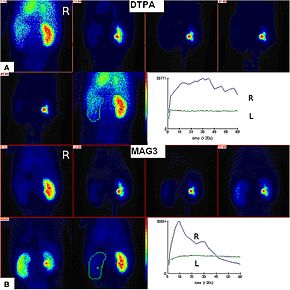Radioisotope renography
| Radioisotope renography | |
|---|---|
 Renal imaging using 99mTc DTPA and 99mMAG3 with renographic curves | |
| ICD-9-CM | 92.03 |
| MeSH | D011866 |
| OPS-301 code | 3-706 |
Radioisotope renography is a form of
The two most common radiolabelled pharmaceutical agents used are 99mTc-MAG3 (MAG3 is also called "mercaptoacetyltriglycine" or "mertiatide") and 99mTc
Scan procedure
After injection into the
If the kidney is not getting blood for example, it will not be viewed at all, even if it looks structurally normal in
Tracers

MAG3 is preferred over 99mTc DTPA in
99mTc DTPA is filtered by the
Clinical use
The technique is very useful in evaluating the functioning of kidneys. Radioisotopes can differentiate between passive dilatation and obstruction. It is widely used before kidney
The use of the test to identify reduced kidney function after test doses of captopril (an
History
In 1986, MAG3 was developed at the University of Utah by Dr. Alan R. Fritzberg, Dr. Sudhakar Kasina, and Dr. Dennis Eshima.
Before the development of tracers such as 99mTc-MAG3, a range of other radiopharmaceuticals were employed. The test was first introduced in 1956, using
99mTc-MAG3 has replaced 131I-OIH because of better quality imaging regardless of the level of kidney function,[29] and lower radiation doses.[24]
See also
References
- ^ "The Renogram". British Nuclear Medicine Society. Retrieved 27 April 2017.
- ^ PMID 24549283.
- ISBN 9783642194269.
- S2CID 24979005.
- ISBN 9780781732529.
- S2CID 11496497.
- PMID 18765635.
- ISBN 9783540280262.
- ^ ISBN 9780972647878.)
{{cite book}}: CS1 maint: multiple names: authors list (link - PMID 12411866.
- PMID 27789752.
- PMID 1534577.
- PMID 8475609.
- PMID 8176469.
- PMID 29395726.
- PMID 29561854.
- PMID 31338652.
- PMID 8294993.
- S2CID 36864545.
- PMID 8862302.
- PMID 9351069.
- PMID 2934521.
- S2CID 8632649.
- ^ S2CID 23594754.
- PMID 13376984.
- PMID 14441893.
- ^ "123I iodohippurate" (PDF). Guidelines database. Federatie Medisch Specialisten. Retrieved 26 August 2022.
- ISBN 978-1-4160-3204-5.)
{{cite book}}: CS1 maint: location missing publisher (link - PMID 2948212.
